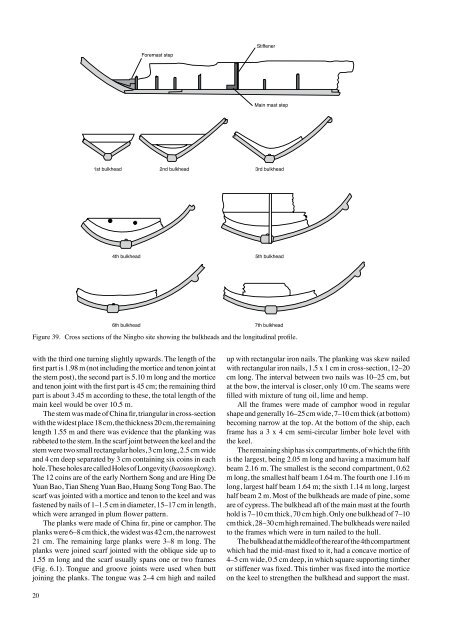No. 237 Maritime Archaeology in the People's Republic of China ...
No. 237 Maritime Archaeology in the People's Republic of China ...
No. 237 Maritime Archaeology in the People's Republic of China ...
Create successful ePaper yourself
Turn your PDF publications into a flip-book with our unique Google optimized e-Paper software.
Figure 39.<br />
20<br />
Foremast step<br />
Stiffener<br />
Ma<strong>in</strong> mast step<br />
1st bulkhead 2nd bulkhead 3rd bulkhead<br />
4th bulkhead<br />
5th bulkhead<br />
6th bulkhead 7th bulkhead<br />
Cross sections <strong>of</strong> <strong>the</strong> N<strong>in</strong>gbo site show<strong>in</strong>g <strong>the</strong> bulkheads and <strong>the</strong> longitud<strong>in</strong>al pr<strong>of</strong>ile.<br />
with <strong>the</strong> third one turn<strong>in</strong>g slightly upwards. The length <strong>of</strong> <strong>the</strong><br />
first part is 1.98 m (not <strong>in</strong>clud<strong>in</strong>g <strong>the</strong> mortice and tenon jo<strong>in</strong>t at<br />
<strong>the</strong> stem post), <strong>the</strong> second part is 5.10 m long and <strong>the</strong> mortice<br />
and tenon jo<strong>in</strong>t with <strong>the</strong> first part is 45 cm; <strong>the</strong> rema<strong>in</strong><strong>in</strong>g third<br />
part is about 3.45 m accord<strong>in</strong>g to <strong>the</strong>se, <strong>the</strong> total length <strong>of</strong> <strong>the</strong><br />
ma<strong>in</strong> keel would be over 10.5 m.<br />
The stem was made <strong>of</strong> Ch<strong>in</strong>a fir, triangular <strong>in</strong> cross-section<br />
with <strong>the</strong> widest place 18 cm, <strong>the</strong> thickness 20 cm, <strong>the</strong> rema<strong>in</strong><strong>in</strong>g<br />
length 1.55 m and <strong>the</strong>re was evidence that <strong>the</strong> plank<strong>in</strong>g was<br />
rabbeted to <strong>the</strong> stem. In <strong>the</strong> scarf jo<strong>in</strong>t between <strong>the</strong> keel and <strong>the</strong><br />
stem were two small rectangular holes, 3 cm long, 2.5 cm wide<br />
and 4 cm deep separated by 3 cm conta<strong>in</strong><strong>in</strong>g six co<strong>in</strong>s <strong>in</strong> each<br />
hole. These holes are called Holes <strong>of</strong> Longevity (baosongkong).<br />
The 12 co<strong>in</strong>s are <strong>of</strong> <strong>the</strong> early <strong>No</strong>r<strong>the</strong>rn Song and are H<strong>in</strong>g De<br />
Yuan Bao, Tian Sheng Yuan Bao, Huang Song Tong Bao. The<br />
scarf was jo<strong>in</strong>ted with a mortice and tenon to <strong>the</strong> keel and was<br />
fastened by nails <strong>of</strong> 1–1.5 cm <strong>in</strong> diameter, 15–17 cm <strong>in</strong> length,<br />
which were arranged <strong>in</strong> plum flower pattern.<br />
The planks were made <strong>of</strong> Ch<strong>in</strong>a fir, p<strong>in</strong>e or camphor. The<br />
planks were 6–8 cm thick, <strong>the</strong> widest was 42 cm, <strong>the</strong> narrowest<br />
21 cm. The rema<strong>in</strong><strong>in</strong>g large planks were 3–8 m long. The<br />
planks were jo<strong>in</strong>ed scarf jo<strong>in</strong>ted with <strong>the</strong> oblique side up to<br />
1.55 m long and <strong>the</strong> scarf usually spans one or two frames<br />
(Fig. 6.1). Tongue and groove jo<strong>in</strong>ts were used when butt<br />
jo<strong>in</strong><strong>in</strong>g <strong>the</strong> planks. The tongue was 2–4 cm high and nailed<br />
up with rectangular iron nails. The plank<strong>in</strong>g was skew nailed<br />
with rectangular iron nails, 1.5 x 1 cm <strong>in</strong> cross-section, 12–20<br />
cm long. The <strong>in</strong>terval between two nails was 10–25 cm, but<br />
at <strong>the</strong> bow, <strong>the</strong> <strong>in</strong>terval is closer, only 10 cm. The seams were<br />
filled with mixture <strong>of</strong> tung oil, lime and hemp.<br />
All <strong>the</strong> frames were made <strong>of</strong> camphor wood <strong>in</strong> regular<br />
shape and generally 16–25 cm wide, 7–10 cm thick (at bottom)<br />
becom<strong>in</strong>g narrow at <strong>the</strong> top. At <strong>the</strong> bottom <strong>of</strong> <strong>the</strong> ship, each<br />
frame has a 3 x 4 cm semi-circular limber hole level with<br />
<strong>the</strong> keel.<br />
The rema<strong>in</strong><strong>in</strong>g ship has six compartments, <strong>of</strong> which <strong>the</strong> fifth<br />
is <strong>the</strong> largest, be<strong>in</strong>g 2.05 m long and hav<strong>in</strong>g a maximum half<br />
beam 2.16 m. The smallest is <strong>the</strong> second compartment, 0.62<br />
m long, <strong>the</strong> smallest half beam 1.64 m. The fourth one 1.16 m<br />
long, largest half beam 1.64 m; <strong>the</strong> sixth 1.14 m long, largest<br />
half beam 2 m. Most <strong>of</strong> <strong>the</strong> bulkheads are made <strong>of</strong> p<strong>in</strong>e, some<br />
are <strong>of</strong> cypress. The bulkhead aft <strong>of</strong> <strong>the</strong> ma<strong>in</strong> mast at <strong>the</strong> fourth<br />
hold is 7–10 cm thick, 70 cm high. Only one bulkhead <strong>of</strong> 7–10<br />
cm thick, 28–30 cm high rema<strong>in</strong>ed. The bulkheads were nailed<br />
to <strong>the</strong> frames which were <strong>in</strong> turn nailed to <strong>the</strong> hull.<br />
The bulkhead at <strong>the</strong> middle <strong>of</strong> <strong>the</strong> rear <strong>of</strong> <strong>the</strong> 4th compartment<br />
which had <strong>the</strong> mid-mast fixed to it, had a concave mortice <strong>of</strong><br />
4–5 cm wide, 0.5 cm deep, <strong>in</strong> which square support<strong>in</strong>g timber<br />
or stiffener was fixed. This timber was fixed <strong>in</strong>to <strong>the</strong> mortice<br />
on <strong>the</strong> keel to streng<strong>the</strong>n <strong>the</strong> bulkhead and support <strong>the</strong> mast.

















